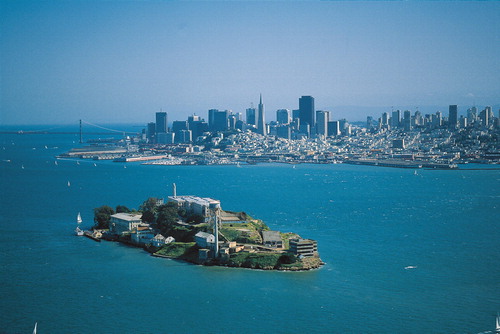The Rock: Hard Place To Beat for Intrigue
Most years, the chances that someone attending APA’s annual meeting will end up in prison are somewhere between slim and none. All bets are off, however, when the meeting’s host city is San Francisco.
 Sitting on a forbidding piece of rock in the middle of picturesque San Francisco Bay, Alcatraz stands ready to receive psychiatrists or anyone else who wants to experience what the nation’s most dangerous and intractable felons once endured.
Sitting on a forbidding piece of rock in the middle of picturesque San Francisco Bay, Alcatraz stands ready to receive psychiatrists or anyone else who wants to experience what the nation’s most dangerous and intractable felons once endured.
During the Great Depression, officials at the federal Bureau of Prisons decided they needed an isolated site where they could confine prisoners who were too difficult to manage in other prisons throughout the country. Such a concentration of the prison system’s hardest cases had not been tried in the United States before 1934, when Alcatraz took in its first inmates.
Alcatraz began life in 1853 as a U.S. military fortress whose cannons were designed to put a quick and decisive end to the plans of foreigners who wanted a share of the wealth made possible by the discovery of gold in California in 1849.
The U.S. Army next decided that the isolated rock jutting out from treacherous waters would be an excellent home for Confederate prisoners captured during the Civil War. After San Francisco’s devastating 1906 earthquake leveled mainland prisons, the government began shipping civilian prisoners there.
The Army turned the prison over to the Department of Justice in 1934, an era in which poverty, Prohibition, and other factors led to warfare among gangsters on the streets on many U.S. cities. It fulfilled the government’s need to appear to be doing something dramatic about the escalating violence and a growing public outcry about it.
The federal prison was turned into an escape-proof fortress, with such “innovations” as cemented-over utility tunnels, state-of-the-art bars and security measures, and Special Gun Galleries, where guards could patrol without any chance inmates could reach them and the keys they carried.
All inmates were housed in single cells, and in the first few months they were allowed no visitors or access to newspapers or magazines. Privileges, including work and sending or receiving mail, had to be earned and could disappear after the slightest infraction of the prison’s rules.
Among the famous prisoners who found themselves on The Rock were Al Capone; Machine Gun Kelly; Floyd Hamilton, who drove getaway cars for Bonnie and Clyde; and Robert Stroud, a murderer who gained fame thanks to Burt Lancaster’s Oscar-winning portrayal of him in the film “The Birdman of Alcatraz.”
Another Hollywood portrayal of doings at The Rock was the 1979 Clint Eastwood film “Escape From Alcatraz.” In fact, there have been 14 documented escapes from the “escape-proof” prison. In 13 of them, however, the fleeing inmates were either captured, killed, or drowned in the cold, churning waters of San Francisco Bay.
Forty years ago, in the 13th escape—the one portrayed in the film—three inmates, Frank Morris and brothers John and Clarence Anglin, not only escaped but vanished. The government assumes that they all drowned, but their bodies have never been found.
In March 1963 U.S. Attorney General Robert Kennedy ordered the expensive and badly deteriorated prison closed. The next time Alcatraz made news was when a group of American Indians landed on the island and claimed that it belonged to Native Americans. Oral histories of people who lived in what became California indicate that indigenous people occupied the island thousands of years before Spanish explorers “discovered” it.
In spring Alcatraz is open from 9:30 a.m. to 4:30 p.m. Since Alcatraz is an extremely popular destination, visitors are advised to buy tickets in advance. Tickets are available from the Blue & Gold Fleet, which operates ferries to the island, on the Web at www.blueandgoldfleet.com or by phone at (415) 705-5555. ▪



